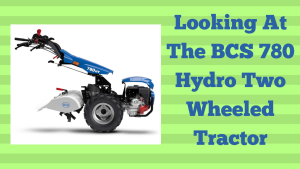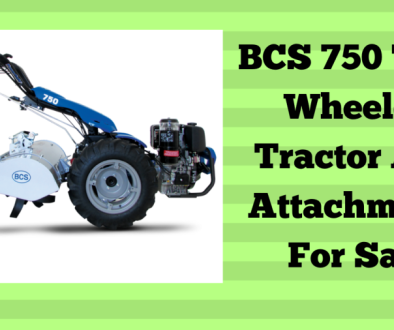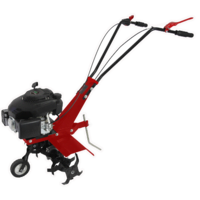Looking At The BCS 780 Hydro Two Wheeled Tractor

In this video and blog post, we are going to be looking at the BCS 780 Hydro two-wheeled tractor. A few years ago, I put up a post on a similar model of BCS two-wheeled tractor, which was the BCS 770HY, it looks like this model has been superseded by the BCS 780 Hydro.

In case you don’t know what hydrostatic transmission is, it’s a way of transmitting power to the wheels by a hydraulic motor which gives you variable speed in forward and reverse. It’s much quicker than the traditional clutch and gearbox way and saves lots of time and has many advantages. Hydrostatic drives on mowers and harvesting machinery are brilliant as you just have that instant control in forward or reverse without any need to use a clutch, so it makes the output considerably better than the gearbox model.
To Find Out More Have A Look At The Video Below
&;
Today, we’re looking at the BCS 780 Hydro two-wheeled tractor. A few years ago, I wrote a blog post on the BCS 770 Hydrostatic Rotavator, and I think they’ve just updated it slightly. I don’t think it’s that different, but we’ll have a look at the specifications in a moment.
Let’s check out this video from Matt the Farmer.
Here, you can see it in action. It’s hydrostatic, meaning it’s variable speed, which I’ll explain more about in a minute. You can see how it speeds up or slows down just by adjusting the lever. This is much better than a gearbox.
He’s working deep in the soil because the crumbler bar adjusts the rotavator depth. The handles can also be offset, which is great because it saves you from treading on freshly dug soil, especially when it’s damp.
Specifications
If we go to BCS’s website, here’s the BCS 780 with the rotavator and the Honda engine.
Hydrostatic means it’s variable speed. These wheels are driven by a hydraulic motor (a hydrostatic motor), allowing forward and reverse movement without a clutch. You simply push the lever forward to move forward, and the further you push it, the faster it goes. The same applies in reverse.
You Can Find More Cultivators And Tillers Here
The handles rotate 180 degrees, and there’s a PTO (Power Take Off) where the rotavator attaches. This PTO can accommodate various accessories, which we’ll look at shortly.
This model features a Honda engine, but there’s also a Yanmar diesel option. You can choose between electric or recoil start. Personally, I’d go for the Honda. I like diesel engines, but some single-cylinder diesel engines can vibrate quite a bit. The Honda has much less vibration, making it quieter and more comfortable to use.
Since red diesel is now harder to get in the UK, a Honda engine might be the better option, given its reliability.
Attachments & Accessories
The handles can rotate 180 degrees. In this image, there’s a topper attached, and here’s the rotavator again. This looks like a rotary plough, which I’ve never used, but it seems like a handy tool for breaking up soil when conditions are right.
Now, looking at the pricing:
The Yanmar diesel with electric start is the most expensive at £7,762 (including VAT).
The cheapest petrol version with a recoil start is £5,694 (including VAT).
These prices do not include attachments—those are sold separately.
More Features
The crumbler bar is adjustable. The higher you lift the bar, the deeper the rotavator digs. It works well in dry conditions, but if the soil is damp, it can clog up quickly. However, it’s great for levelling and breaking down soil.
The handlebars have built-in dampers to reduce vibration from the engine. Matt the Farmer mentioned that they feel a bit loose, but this is intentional—it helps absorb vibration, making it more comfortable to use. Initially, it might feel odd, but it’s actually a useful feature.
Common Attachments
There are plenty of attachments available, including:
Rotavators (18″, 20″, 26″, 32″, and 34″)
Flail mower
Precision depth roller (as seen in the video)
Ridgers for potatoes
Sickle bar mower / Scythe mower
Rotary plow
Cultivator
Barrow
Buck rake
Power harrow
Dozer blade
Chipper
Rotary brush
Hay rake
Snow plow
Reversible plow
Stone burier
Mulching mower
Seed planter
Leaf blower
Mini baler
You could spend a fortune on attachments, but that’s what I like about the BCS—it’s versatile. You have one power unit, and you can swap out the attachments as needed. That’s a huge advantage.
Warranty & Second Hand Market
The warranty is:
2 years for commercial use
3 years for domestic use
That shows BCS has confidence in their machines. Many hire companies use them, which is a good sign of their durability.
If you’re looking for a secondhand model, there are usually options available. BCS machines are also branded as CAMON, though I’m not entirely sure what the differences are.
On eBay, there are often listings, and they hold their value well. I saw a 2000/2001 model—about 23 or 24 years old—that still looked in good condition, meaning these machines last a long time.
Final Thoughts
For the base machine without VAT, you’re looking at £4,745. If you’re a contractor, it’s not a huge investment, considering the years of service you’d get from it.
You can find the BCS 780 Hydro two will tractor on the main website here.
If you have any comments or questions, feel free to leave them below.
Thanks for watching and reading!


